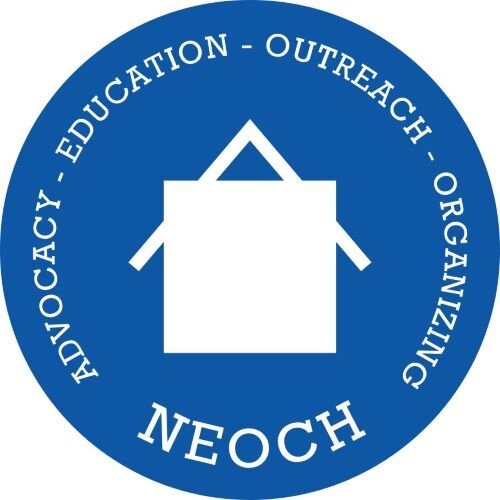Cleveland Provides Hospitality to Evacuees
by Brian Davis
City and County officials responded quickly after Hurricane Katrina to quickly assemble a welcoming committee for evacuees from the Gulf region. The Red Cross coordinated all disaster services and attempted to make contact with all those who had settled in the Cleveland area. After three weeks, over 250 families had relocated to the Greater Cleveland or roughly 660 people. There was an anticipated plane-load of people coming to Cleveland of an additional 250-500 people, but that never materialized. Instead, most evacuees made it to Cleveland and were staying with family and friends who lived in Cleveland.
The convention center in Downtown Cleveland was prepared with 400 beds and 40 temporary showers for the plane of evacuees. A three-day fair was organized, which featured almost every potentially needed service. First Call for Help put together a resource guide for those seeking assistance. The new website housingcleveland.org was offered as a resource for possible housing opportunities. Cleveland Community Voice Mail offered toll-free telephone numbers so that families spread across the United States could exchange messages. The postal service assisted with post office boxes so that families could have their mail forwarded.
The Cleveland Department of Aging also offered help. Many of the human services staff in Cuyahoga County provided assistance. RTA was going to provide transportation from the airport when the plane arrived. Ten local hospitals offered medical personnel for assistance. Coats for Kids was present with a large amount of clothing. An impressive computer center was constructed to offer Internet access for evacuees. There were legal services and the Cleveland Public Schools were on hand to immediately enroll children in school.
The goal was to find housing for the evacuees within two weeks and close the Convention Center shelter. Even though the shelter was never needed, the City of Cleveland Department of Community Development took the lead in coordinating housing assistance for the evacuees from Louisiana, Mississippi, and Alabama. The Department of Housing and Urban Development offered transfers to those relocating from public housing or who had a housing voucher before the hurricane, which were only a handful of people. The rest of evacuees were offered a FEMA housing voucher that could be renewed for up to 18 months. This FEMA voucher would pay for housing at Fair Market rent for 18 months as long as the unit passed an inspection.
According to those who participated in the relief effort, the Community Development Department did an impressive job of coordinating the huge outpouring of goodwill by landlords, organizations, and churches and attempting to match those resources with people in need. Certainly, editors of the Grapevine and officials of the Coalition repeatedly heard, “Why can’t we offer this level of help for our own homeless population?” There were several letters to the Plain Dealer along these lines as well. The simple answer is that the evacuees were coming to Cleveland with money that homeless people in Cleveland do not have (see statement from NEOCH).
The Resident Council of 2100 Lakeside raised the same issue at their monthly meeting. They met with John Wilbur and Bill Ressegger of the City of Cleveland Department of Community Development to ask for help in moving some of the goodwill that came from the Hurricane Katrina relief to be directed at the men’s shelter at 2100 Lakeside. The City officials were very sympathetic to concerns of the residential leaders from the shelter, and the three men all came away feeling that they had opened a fruitful dialogue. There are future meetings set with the City to discuss these issues “after the dust settles, and all the evacuees are settled into housing.”
Along with coordinating housing assistance, the City Department of Community Development was attempting to match church and organizations with families to provide follow-up services like dishes, house wares, and just a shoulder to lean on for the families. 75 to 100 churches had stepped forward, including many of the congregations from Interfaith Hospitality Network to assist. The hope was that the churches could provide the ongoing assistance to transport the families around town, help them with settling into a new city, and acting as mentor to the families.
Cuyahoga County stepped forward to cut through some of the red tape with regard to Medicaid, cash assistance, and food stamps. The Department was offering a one-time cash advance to assist with relocation. This money was available in a timely fashion, unlike the cash assistance provided by FEMA. After the three days at the Convention Center, Cuyahoga County set up a special unit for Hurricane relief at the Virgil Brown Center to continue the assistance. Throughout the entire relocation process, counseling services were offered to the families traumatized by the destruction of their home city. The Red Cross and the local Mental Health Board have offered trauma specialists on site to assist with stress, depression, and dealing with the feeling of hopelessness often associated with natural disasters.
While the City did not have a plane-load of evacuees, we have had a slow trickle of families finding their way up to Cleveland. County and City officials have gone out of their way to provide a little “southern hospitality” for the victims of Hurricane Katrina. From churches opening up their doors to public employees trying to eliminate red tape, the city has truly provided complete wrap-around services to a group of people who will be starting over with their lives. There were many at the planning table who wanted to show the Best of Cleveland in an effort to keep some of these evacuees as permanent citizens.
Copyright Homeless Grapevine and the Northeast Ohio Coalition for the Homeless, Cleveland Ohio October 2005, Issue 73.
